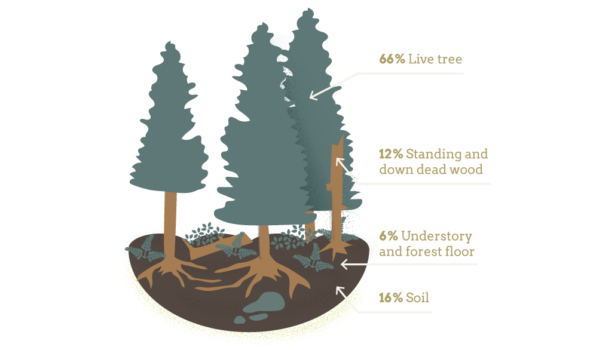Answers in the Trees
Understanding the role of Northwest forests in tackling climate change
More and more, we’re reading about how trees can be a solution to climate change. (We wrote about it in the previous issue of Fieldbook, in fact.) The topic has generated a number of questions about what trees can do, what they can’t do, and how we can best go about working with forests as a climate solution strategy. To answer these questions, let’s start with the basics.
We are connected to trees—and, really, most plants—by the carbon cycle. You might remember from biology class: we breathe in oxygen and breathe out carbon dioxide. Trees and other plants photosynthesize, absorbing sunlight, water, and carbon dioxide to make sugars, some of which are stored as structural material, including wood. Carbon is stored within these structures until they decompose, burn, or are otherwise consumed.
Unfortunately, we’ve tipped the global scales of this cycle far out of balance over the past 170 years by burning fossil fuels and emitting carbon dioxide and other greenhouse gases in order to power our modern lives.
There are two ways to restore some semblance of balance to the carbon cycle: reduce emissions from fossil fuel use and increase the carbon-absorbing power of forests and other plant-rich landscapes. Both methods are needed. We call the latter approach a “natural climate solution.”
Forests, especially the verdant, fast-growing forests of western Oregon and Washington, already provide a number of benefits before even taking carbon storage into account, including wood products, forestry jobs, world-class recreation, wildlife habitat, and clean air and water. “People manage forests for multiple purposes,” says Lydia Mendoza, conservation lead with Columbia Land Trust. “Carbon sequestration is one of many crucial values that forests can provide.” Leveraging the carbon-sequestering power of forests involves balancing values and evolving as we learn.
Carbon accounting, though, as Mendoza notes, is not an exact science. This is certainly the case when we examine the carbon implications of forestry. Forest practices vary by entity, end product, tree species, topography, and geography. In general, trees harvested for structural lumber (wood used as building material) hold sequestered carbon for longer periods of time than trees used for other wood products. That said, not all of the tree material in a forest will become structural lumber. A large portion of it will remain on site in the form of residual limbs, tops, foliage, stumps, and roots, or the harvested material will become processed into pulp and paper products, which will decompose rapidly. When tracking carbon tied to forestry, it’s important to also consider the carbon emissions associated with machines used to cut, haul, and mill timber.

Carbon Distribution in a Northwest Douglas-fir forest (75 years)
Given our current understanding of forest carbon, how can Columbia Land Trust best leverage the carbon-storing power of our Northwest forests? Should we stop cutting and leave our forests alone? Should we harvest forests more rapidly and plant new trees to sequester even more carbon? Neither extreme is practical. For us, blending knowledge about forest carbon into our long-standing conservation values is already informing which lands we prioritize conserving as well as how we manage the forests we already steward.
On the ground, this could look like thinning forests and giving the remaining trees room to grow faster, adding in more diversity of tree species and age, and extending harvest rotations from every 35 to every 70 years. This approach both supports forest-dependent jobs and puts timberlands on a trajectory toward becoming more complex, with structure and tree species that serve wildlife and carbon sequestration well. In some cases, they may become old-growth forests.
It was once argued that old-growth forests were poor at sequestering carbon because centuries-old trees don’t photosynthesize or grow much compared to younger trees. In reality, old-growth forests—which have already trapped a tremendous amount of carbon not only in standing trunks and limbs but also in roots, in material on the forest floor, and in forest soil—continue to sequester carbon for many decades or even centuries. By conserving older forests and old-growth forests we protect the carbon they’ve stored along with wildlife species that can’t survive anywhere else.
When practicing conservation forestry on younger forests, fire is also a consideration, and at times a point of contention. Mendoza reminds us that no forest should be managed solely for carbon, and that thinning trees can be an important strategy in managing fuel load, preventing conditions where tightly packed trees burn more intensely than they would otherwise.
Like most aspects of our iconic Northwest forests, the biology and accounting behind forest carbon is complex. That said, climate change is already impacting our lands and our communities, from the movement of pests that threaten our crops and forests to warmer river temperatures to more severe floods and droughts. The immediacy of this challenge demands we learn and evolve quickly, with discernment and purpose.
“Climate change is something I think about constantly. If we don’t address it, we can’t protect the lands and wildlife that take care of us,” says Mendoza. “Conserving forests gives us a large role to play, and a tangible action we can take to make a difference in this existential crisis.”
Amidst the isolation and anxiety of a pandemic, Mendoza has found solace in the forests near her home in Astoria. In an era of immense uncertainty, forests remain an invaluable source of answers.